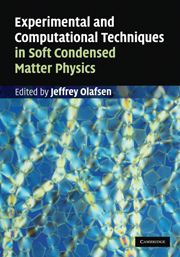Book contents
- Frontmatter
- Contents
- Contributors
- 1 Microscopy of soft materials
- 2 Computational methods to study jammed systems
- 3 Soft random solids: particulate gels, compressed emulsions, and hybrid materials
- 4 Langmuir monolayers
- 5 Computer modeling of granular rheology
- 6 Rheological and microrheological measurements of soft condensed matter
- 7 Particle-based measurement techniques for soft matter
- 8 Cellular automata models of granular flow
- 9 Photoelastic materials
- 10 Image acquisition and analysis in soft condensed matter
- 11 Structure and patterns in bacterial colonies
- Index
- References
9 - Photoelastic materials
Published online by Cambridge University Press: 05 July 2014
- Frontmatter
- Contents
- Contributors
- 1 Microscopy of soft materials
- 2 Computational methods to study jammed systems
- 3 Soft random solids: particulate gels, compressed emulsions, and hybrid materials
- 4 Langmuir monolayers
- 5 Computer modeling of granular rheology
- 6 Rheological and microrheological measurements of soft condensed matter
- 7 Particle-based measurement techniques for soft matter
- 8 Cellular automata models of granular flow
- 9 Photoelastic materials
- 10 Image acquisition and analysis in soft condensed matter
- 11 Structure and patterns in bacterial colonies
- Index
- References
Summary
Introduction
The behavior of dense granular materials, which consist of large collections of individual grains, is an example of a complex system. Despite the relative simplicity of the constituents, the large number of frictional contacts leads to indeterminacy, history dependance, and jamming. We still lack a general set of macroscopic equations to describe their flow. A continuum description of the relevant state variables is desirable, and early studies in soil mechanics focused on characterizing bulk stress/strain relationships and failure. However, it was determined through experiments using photoelastic materials [1–3] that forces transmitted through granular assemblies are carried through an inhomogeneous network of stress chains in which the majority of force is carried through chains of particles comprising a minority of grains (e.g. Figure 9.1(b)). The creation and failure of these chains are central to the fluctuations that can dominate in measurements of dense, granular systems [4].
To visualize internal stresses, these experiments used grains composed of photoelastic materials, which exhibit stress-induced birefringence. When placed between crossed polarizers, in a polariscope, the intensity of transmitted light varies with the local principal stress difference, allowing visualization of the internal stresses in the system. Regions of differential stress appear as a series of bright and dark fringes. The resulting pattern offers both an immediate insight into the spatial stress distribution and the opportunity to measure quantitative local force data in the sample.
Information
- Type
- Chapter
- Information
- Publisher: Cambridge University PressPrint publication year: 2010
